- Clone
- APA5 (See other available formats)
- Regulatory Status
- RUO
- Other Names
- PDGF receptor-α, PDGFR-α
- Isotype
- Rat IgG2a, κ
- Ave. Rating
- Submit a Review
- Product Citations
- publications
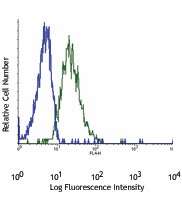
-

Mouse fibroblast NIH/3T3 cells stained with APA5 APC
| Cat # | Size | Price | Save |
|---|---|---|---|
| 135907 | 25 µg | ¥16,020 | |
| 135908 | 100 µg | ¥47,530 |
Platelet-derived growth factor receptor-α (PDGFR-α), CD140a, is one of two receptors for platelet-derived growth factors (PDGFs) and binds to all isoforms of PDGFs: PDGF-AA, PDGF-AB, and PDGF-BB. PDGFRa is a receptor tyrosine kinase that forms homodimers or heterodimers on the surface upon ligand binding and phosphorylates substrates. PDGFRs consist of either homodimers of α/α, β/β, or heterodimers of α/β. PDGF receptors, α and β, are single glycoproteins with intracellular tyrosine kinase domain. Their ligand, PDGF, is a mitogen for connective tissue and glial cells. CD140a is expressed on embryonic tissues and mesenchymal-derived cells of adult mice. PDGF plays a role in wound healing and acts as a chemoattractant for fibroblasts, smooth muscle cells, glial cells, monocytes, and neutrophils.
Product DetailsProduct Details
- Verified Reactivity
- Mouse
- Antibody Type
- Monoclonal
- Host Species
- Rat
- Immunogen
- Mouse PDGFR-α-hIgG1 recombinant fusion protein
- Formulation
- Phosphate-buffered solution, pH 7.2, containing 0.09% sodium azide.
- Preparation
- The antibody was purified by affinity chromatography, and conjugated with APC under optimal conditions.
- Concentration
- 0.2 mg/ml
- Storage & Handling
- The antibody solution should be stored undiluted between 2°C and 8°C, and protected from prolonged exposure to light. Do not freeze.
- Application
-
FC - Quality tested
- Recommended Usage
-
Each lot of this antibody is quality control tested by immunofluorescent staining with flow cytometric analysis. For flow cytometric staining, the suggested use of this reagent is ≤ 1.0 µg per 106 cells in 100 µl volume. It is recommended that the reagent be titrated for optimal performance for each application.
- Excitation Laser
-
Red Laser (633 nm)
- Application Notes
-
Additional reported (for relevant formats) applications include: Western Blot, blocking function2, and immunohistochemical staining of paraffin and frozen sections. The LEAF™ purified antibody is recommended for functional assays.
-
Application References
(PubMed link indicates BioLegend citation) -
- Takakura N, et al. 1996. J. Invest. Dermatol. 107:770.
- Liao C, et al. 2010. J. Clin. Invest. 120:242. (Block)
- Chen H, et al. 2015. ASN Neuro 8:7. PubMed.
- Miyawaki T, et al. 2004. J Neurosci. 24(37): 8124-34. (IHC-F)
- Product Citations
-
- RRID
-
AB_2043969 (BioLegend Cat. No. 135907)
AB_2043970 (BioLegend Cat. No. 135908)
Antigen Details
- Structure
- Alpha chain of the platelet-derived growth factor receptor, a receptor tyrosine kinase that forms homo- or hetero-dimers on the surface after ligand binding.
- Distribution
-
Expressed on embryonic tissues and mesenchymal-derived cells of adult mouse.
- Function
- Play a role in wound healing and act as a chemoattractant for fibroblasts, smooth muscle cells, glial cells, monocytes and neutrophils.
- Ligand/Receptor
- PDGFs
- Cell Type
- Embryonic Stem Cells, Mesenchymal cells, Mesenchymal Stem Cells
- Biology Area
- Cell Biology, Immunology, Neuroscience, Neuroscience Cell Markers, Stem Cells
- Molecular Family
- CD Molecules, Cytokine/Chemokine Receptors
- Antigen References
-
1. Mukouyama YS, et al. 2006. Proc Natl Acad Sci USA. 103(5):1551
2. Miyawaki T, et al. 2004. J Neurosci. 24(37):8124
3. Takakura N, et al. 1997. J Histochem Cytochem. 45(6):883 - Gene ID
- 18595 View all products for this Gene ID
- UniProt
- View information about CD140a on UniProt.org
Related Pages & Pathways
Pages
Related FAQs
Other Formats
View All CD140a Reagents Request Custom Conjugation| Description | Clone | Applications |
|---|---|---|
| Purified anti-mouse CD140a | APA5 | FC,WB,IHC-P,IHC-F |
| PE anti-mouse CD140a | APA5 | FC |
| APC anti-mouse CD140a | APA5 | FC |
| Biotin anti-mouse CD140a | APA5 | FC |
| PerCP/Cyanine5.5 anti-mouse CD140a | APA5 | FC |
| PE/Cyanine7 anti-mouse CD140a | APA5 | FC |
| Brilliant Violet 605™ anti-mouse CD140a | APA5 | FC |
| TotalSeq™-A0573 anti-mouse CD140a | APA5 | PG |
| Brilliant Violet 421™ anti-mouse CD140a | APA5 | FC |
| PE/Cyanine5 anti-mouse CD140a | APA5 | FC |
| PE/Dazzle™ 594 anti-mouse CD140a | APA5 | FC |
| TotalSeq™-C0573 anti-mouse CD140a | APA5 | PG |
| TotalSeq™-B0573 anti-mouse CD140a | APA5 | PG |
Customers Also Purchased
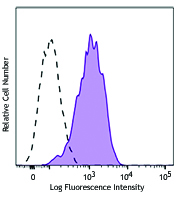
Compare Data Across All Formats
This data display is provided for general comparisons between formats.
Your actual data may vary due to variations in samples, target cells, instruments and their settings, staining conditions, and other factors.
If you need assistance with selecting the best format contact our expert technical support team.
-
Purified anti-mouse CD140a
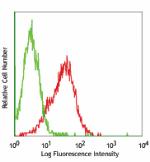
Mouse fibroblast cell line NIH/3T3 stained with APA5 PE 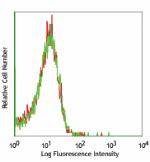
C57BL/6 splenocytes stained with APA5 PE -
PE anti-mouse CD140a
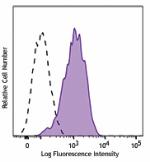
Mouse fibroblast NIH/3T3 cells were stained with CD140a (clo... -
APC anti-mouse CD140a
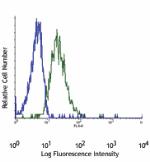
Mouse fibroblast NIH/3T3 cells stained with APA5 APC -
Biotin anti-mouse CD140a
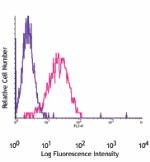
Mouse fibroblast NIH/3T3 cells are stained with biotinylated... -
PerCP/Cyanine5.5 anti-mouse CD140a
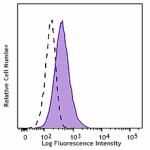
Mouse fibroblast NIH/3T3 cells were stained with CD140a (Clo... -
PE/Cyanine7 anti-mouse CD140a
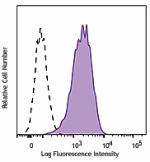
Mouse fibroblast NIH/3T3 cells were stained with CD140a (Clo... -
Brilliant Violet 605™ anti-mouse CD140a
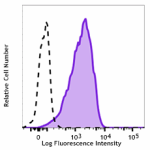
Mouse fibroblast NIH/3T3 cells were stained with anti-mouse ... -
TotalSeq™-A0573 anti-mouse CD140a
-
Brilliant Violet 421™ anti-mouse CD140a
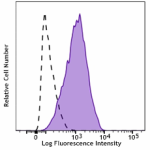
Mouse fibroblast NIH/3T3 cells were stained with CD140a (clo... -
PE/Cyanine5 anti-mouse CD140a
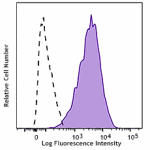
Mouse fibroblast NIH/3T3 cells were stained with CD140a (clo... -
PE/Dazzle™ 594 anti-mouse CD140a
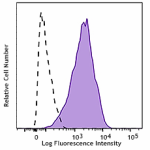
Mouse fibroblast NIH/3T3 cells were stained with CD140a (clo... -
TotalSeq™-C0573 anti-mouse CD140a
-
TotalSeq™-B0573 anti-mouse CD140a










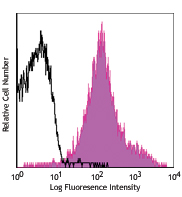
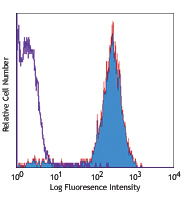




Follow Us